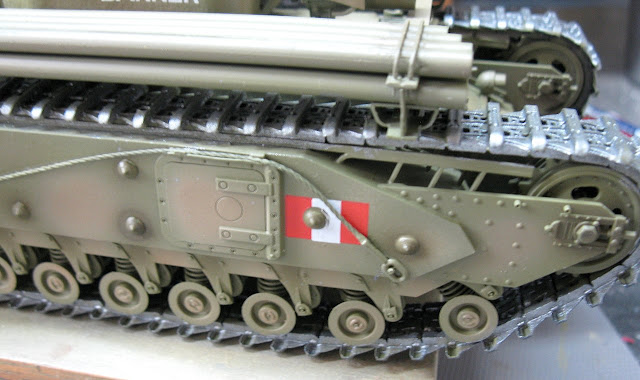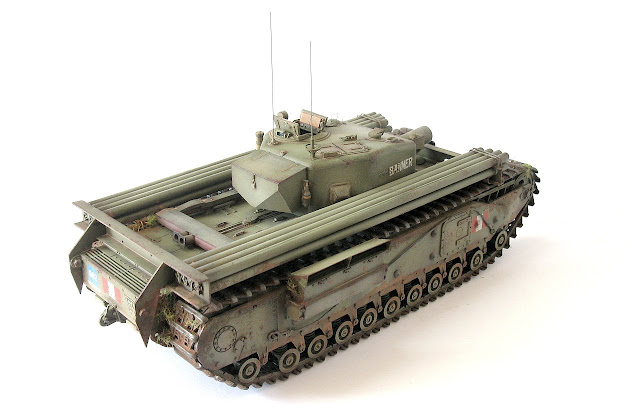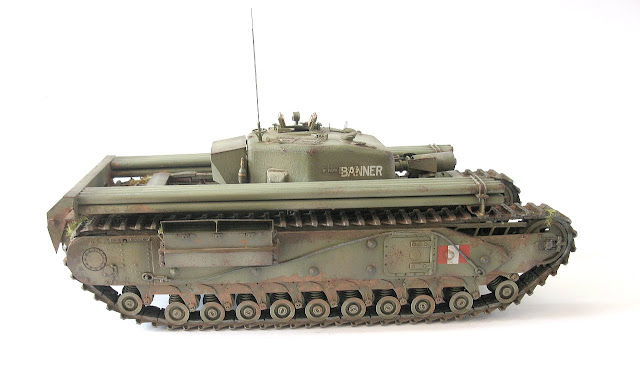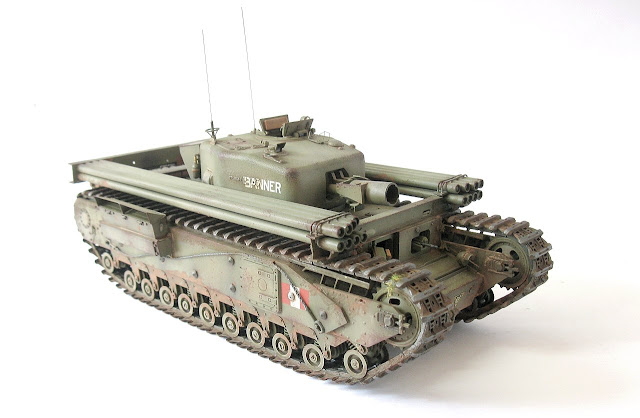Royal Engineers and Sappers!!!
 |
| Churchill Mk.IV AVRE Snake (Wurlitz) A little joke with the box art of AFVClub´s kit. |
History
 |
| German soldiers inspect the imobilized Churchill Mk.III tank BERT left by the Calgary Regiment at Dieppe - August, 1942. font: Library and Archives Canada |
 |
| Major-General Sir Percy Cleghorn Stanley Hobart, KBE, CB, DSO, MC (14 June 1885 – 19 February 1957), aka "Hobo" and badge of the 79th Armoured Division |
.jpg) |
| Sherman tank dragging a Snake, by means of an ejectable chain, tied to the rear of the tank - font: IWM (MGH 106) - 3,25sec. |
.jpg) |
| The tip of the Snake device, rounded, so it can slide along the ground. Close-up view. font: IWM (MGH 106) - 3,13sec. |
.jpg) |
| The Sherman tank approaching the rear of the Snake, to capture its base with the chain installed at the bow of the vehicle. font: IWM (MGH 106) - 2,37sec. |
.jpg) |
| The chain in the bow of the Sherman tank hooking the base of the Snake. font: IWM (MGH 106) - 2,39sec. |
.jpg) |
| The Snake is fully engaged with the bow chain. The tank will now push the long tube forward... font: IWM (MGH 106) - 2,40sec. |
.jpg) |
| The Snake is pushed into position. Upon reaching the desired location, the tank reverses, unhooking the Snake from the bow chain. font: IWM (MGH 106) - 2,59sec. |
.jpg) |
| The right Snake tubes being loaded with torpedoes, from the front, manually. font: IWM (MGH 106) - 1943 |
.jpg) |
| The Snake tubes being loaded with torpedoes, from the front, manually. Close view font: IWM (MGH 106) - 1943 |
 |
| The Churchill Mk.IV AVRE Snake tank fully reloaded, ready for field trials. font: IWM (MGH 106) - 1943 |
 |
| The Churchill Mk.IV AVRE Snake tank fully reloaded, ready for field trials. Rear vision. font: IWM (MGH 106) - 1943 |
 |
| Sequence of firing a Snake tube from the Churchill Mk.IV AVRE Snake tank - field tests. Shot number 1 font: IWM (MGH 106) - 1943 |
 |
| Sequence of firing a Snake tube from the Churchill Mk.IV AVRE Snake tank - field tests. Shot number 2 - Snake torpedoe being fired from the tubes. font: IWM (MGH 106) - 1943 |
 |
| Sequence of firing a Snake tube from the Churchill Mk.IV AVRE Snake tank - field tests. Shot number 3 - Snake torpedo flying after ejection from the launch tube. font: IWM (MGH 106) - 1943 |
 |
| Sequence of firing a Snake tube from the Churchill Mk.IV AVRE Snake tank - field tests. Shot number 4 - Torpedo snake almost touching the ground after ejection. font: IWM (MGH 106) - 1943 |
The Churchill Snake launcher tank was also known as the "Wurlitzer" due to the resemblance of its multiple launch tubes to the pipes of a Wurlitzer organ, a famous musical instrument of the time, which gave rise to an informal and descriptive nickname among Allied personnel. t's important to note that "Wurlitzer tank" or "Churchill AVRE Mk.IV Wurlitz tank" was not an official designation. The vehicle was officially known as the Churchill AVRE Mk.IV carrying the "Snake" mine-clearing equipment.
Based on the same concept, the British also developed the 3-inch gun Churchill tank with Snake launcher, with 50 Snake torpedo tubes on the chassis of the 3-inch gun Churchill tank.
 |
| 3-inch gun Churchill tank with Snake launcher under trials. Note the absence of the 3-inch cannon in the bow of the tank's casemate. font: IWM (MGH 106) - 1943 |
 |
| 3-inch gun Churchill tank with Snake launcher under trials. Notice the Churchill Mk.IV AVRE Snake launcher in background. font: IWM (MGH 106) - 1943 |
 |
| Churchill towing a Bren carrier with Conger launcher |
| Churchill Mk.IV AVRE Snake launcher (Wurlitzer) | |
|---|---|
| Type | Mine clearing tank |
| Place of origin | United Kingdom |
| Production history | |
| Designer |
|
| Manufacturer | Vauxhall Motors & others |
| Produced | 1943 |
| No. built | one conversion (?) |
| Specifications | |
| Mass |
|
| Length | 7.44 m |
| Width | 3.25 m |
| Height | 2.49 m |
| Crew | 5 -commander, gunner, loader/radio operator, driver,co-driver/hull gunner |
| Armour |
|
Main armament |
|
Sec. armament |
|
| Engine | Bedford 12-cyl., 4 stroke, water-cooled, horizontally opposed, L-head petrol engine 325-350 hp (242-261 kW) @ 2,200 rpm |
| Power/weight | 8.4-8.8 hp (6.1-6.4 kW) / tonne |
| Transmission | Merritt-Brown 4-speed constant-mesh epicyclic gearbox |
| Suspension | Coiled spring |
| Fuel capacity | 682 liters |
Operational range | 120–210 km |
| Maximum speed | 21.7–26.4 km/h |
Steering system | Triple differential steering in gearbox |
The kit
I built this kit in parallel with another two other projects, which will soon be featured in our Bunker: Churchills ARV Mk.II. Since they use the same chassis, I decided to build the both Churchills simultaneously, with each going its own way during the detailing phase. So, don't be surprised to see two chassis being built side by side. This usually saves me time, especially during the repetitive build phases. So, let's get to the point: I used for the Snake launcher version the excellent Churchill AVRE with Snake Launcher kit from AFV Models (#35259). AFV Club's Churchill kits are simply fantastic.
 |
| Kojak faces the new challenge: the Churchill AVRE with Snake Launcher |
 |
| The two sets of Churchill sponsons being built simultaneously... The common steps of the construction of the two kits will be portrayed together... |
 |
| Cleaning all the Churchill suspension parts... |
 |
| Springs, springs and more springs... |
 |
| The suspension unit bogies in place, fitted and held by spring pressure... |
 |
| Closing the sponsons... |
 |
| The two sets of suspension unit bogies in place... |
 |
| Starting with the wheels... |
 |
| The sponsons with wheels... |
 |
| ...and with drive sprocket wheels. |
 |
| Closing the chassis... |
 |
| ...with the upper deck. |
 |
| Installing the upper deck and front armor details. left view |
 |
| Right view |
 |
| Rear view |
 |
| Test fit wit the exhaust pipes...left view |
 |
| est fit wit the exhaust pipes...right view |
 |
| Metal work with PE from AFV Club parts... |
 |
| Metal locks... |
 |
| And the two Churchills (Churchill ARV Mk.II and Snake Launcher), side by side, showing the rear decks with metal rods |
 |
| Installing the Snake torpedo tubes over the tank tracks. |
 |
| Front right view |
 |
| Front left view |
 |
| Reinforcing the bond between metal and plastic: PE fragments glued with superglue to the outer face of the front supports |
 |
| Reinforcing the bond between metal and plastic: PE fragments glued with superglue to the inner face of the front supports |
 |
| Panzerserra markings & painting guide |
 |
| Starting with the paintwork, shades of green all over the vehicle... left front view |
 |
| Shades of green all over the vehicle... right front view |
 |
| Applying the AFV Club decals (very good) that come with the kit... |
 |
| In the decal locations, I applied two thin coats of gloss varnish to prevent the formation of the odious silvering. |
 |
| Right side view of the BANNER |
 |
| Rear view of the BANNER |
 |
| Painting the good vinyl tracks with acrylic paint diluted in water (to avoid melting) with a brush and Vallejo Gun Metal paint. |
 |
| The tank's badass look is simply fantastic... |
 |
| The decal drilled and fitted into the conical nut on the side of the tank sponsons. Right view |
 |
| The decal drilled and fitted into the conical nut on the side of the tank sponsons. Left close view |
 |
| Painting the conical nut in the English marking colors, harmonizing the entire set. Right view |
 |
| Painting the conical nut in the English marking colors, harmonizing the entire set. Left view |
 |
| Painting various details on the vehicle... |
 |
| Churchill Mk IV AVRE Snake launcher (Wurlitzer) "BANNER" "Hobart´s Funnies," - 79th Armoured Division 1st Assault Brigade - 42nd Assault Regiment (Royal Engineers.) England, November 1943. |
 |
| Churchill Mk IV AVRE Snake launcher (Wurlitzer) Front left view |
 |
| Churchill Mk IV AVRE Snake launcher (Wurlitzer) Left view |
 |
| Churchill Mk IV AVRE Snake launcher (Wurlitzer) Rear left view |
 |
| Churchill Mk IV AVRE Snake launcher (Wurlitzer) Rear right view |
 |
| Churchill Mk IV AVRE Snake launcher (Wurlitzer) Right view |
 |
| Churchill Mk IV AVRE Snake launcher (Wurlitzer) Front right view |
 |
| Churchill Mk IV AVRE Snake launcher (Wurlitzer) Front left view |
 |
| Churchill Mk IV AVRE Snake launcher (Wurlitzer) with Kojak |
 |
Churchill Mk IV AVRE Snake launcher (Wurlitzer) "BANNER" 1st Assault Brigade - 42nd Assault Regiment (Royal Engineers.) England, November 1943. |





